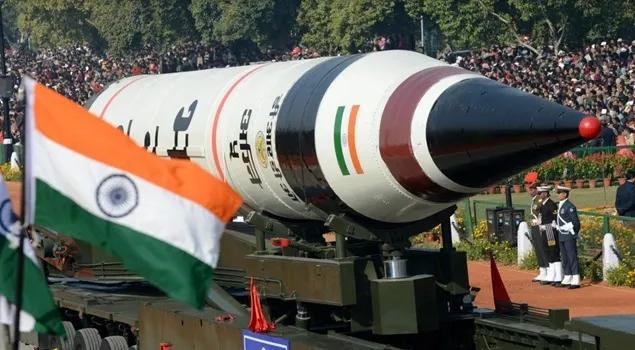22 Mar 2024 - {{hitsCtrl.values.hits}}
 Indian Prime Minister Narendra Modi recently announced the success of Mission Divyastra. This test was conducted by the Defence Research and Development Organization (DRDO), marking India's entry into the prestigious MIRV technology elite club. The indigenous Agni-5 missile is equipped with multiple warheads that showcase India's technological stride in defense capabilities.
Indian Prime Minister Narendra Modi recently announced the success of Mission Divyastra. This test was conducted by the Defence Research and Development Organization (DRDO), marking India's entry into the prestigious MIRV technology elite club. The indigenous Agni-5 missile is equipped with multiple warheads that showcase India's technological stride in defense capabilities.
This achievement represents a significant breakthrough in the nation's pursuit of self-reliance and strategic prowess. It is borne out of relentless scientific innovation and strategic foresight, underscoring India's ascent as a formidable force in global security. Mission Divyastra not only epitomizes India's unwavering commitment to self-reliance but also reshapes regional dynamics while fortifying national security through cutting-edge defense capabilities.
One of the most impressive aspects of Mission Divyastra was the leadership of women scientists and engineers. The 57-year-old Programme Director Sheena Rani is exceptional. With expertise in computer science and electronics, she spent eight years at the Vikram Sarabhai Space Centre and joined the DRDO in 1999, heavily contributing to the Agni missile program. This integration of MIRV technology into Agni-5 highlights India's advanced scientific endeavors, bolstering national security through state-of-the-art defense capabilities.
Prime Minister Modi took to social media to laud the extraordinary achievements of DRDO scientists who spearheaded Mission Divyastra. He specifically commended their groundbreaking work in developing the Agni-5 missile, a pioneering creation equipped with MIRV capability—a first of its kind in India. This indigenous missile system integrates avionics and high-precision sensors, all domestically produced, ensuring unparalleled accuracy in hitting targets during re-entry. This technological feat not only underscores India's growing prowess and sophistication in defense technology but also spotlights the nation's ability to excel in advanced scientific endeavors on a global scale.
MIRV stands for Multiple Independently-targeted Reentry Vehicle. It is a technology for ballistic missiles that allows them to carry multiple warheads. Each warhead can be aimed at a different target, separated by hundreds of kilometers, or they can all hit the same target with greater destructive force. The technology emerged in the early 1960s. It allows a single missile to carry numerous nuclear warheads, each with its re-entry vehicle and targeting system. This significantly increases a missile's destructive potential, with some capable of carrying up to 16 warheads and striking targets over 1,500 kilometers apart. It is typically used with intercontinental ballistic missiles (ICBMs) that carry thermonuclear warheads, but the concept can be applied to other types of missiles as well. A simpler version, called Multiple Reentry Vehicle (MRV), scatters warheads without individually targeting them.
The United States was the first to develop MIRVs, deploying them on land-based and submarine-launched missiles in 1970 and 1971 respectively. The Soviet Union followed suit by the late 1970s. Today, several other countries including the UK, France, and China also possess MIRV technology. India now joins this elite group.
India's DRDO has developed the MIRV-tipped long-range nuclear missile Agni-5, representing an ace of indigenous design. It features a heat shield that protects the missile from extreme temperatures, advanced navigation systems, and a powerful engine. This three-stage, 17-meter-tall missile boasts a range of 5,000 km and can carry a 1.5-ton nuclear warhead. Additionally, it is equipped with fault-tolerant software for reliable operation. The key distinguishing feature of Agni-5 is its extended range, surpassing that of India's other Agni missiles (II, III, and IV) which have shorter ranges. Agni-5 qualifies as an intercontinental ballistic missile (ICBM) due to its range exceeding 7,000 kilometers. It was first tested in 2012 and is designed in a canisterized format for faster launch times.
The impressive range of Agni-5 covers all of China, including its eastern coast. Looking forward, India is in the process of developing the even longer-range Agni-VI missile, exceeding 10,000 kilometers. While Agni-V already reaches all of China, Agni-VI will extend India's potential strike zone to encompass all of Europe, Asia, Africa, Oceania, and even parts of North America. This technological advancement accentuates India's strategic capabilities and its position as a significant player in the global defense.
In an effort to make India self-sufficient in missile technology, a program called the IGMDP was proposed by the leading missile scientist A.P.J. Abdul Kalam, who later became President of India. The program was finally approved by the government in June 1983. Led by Dr. Kalam, the DRDO and the Ordnance Factories Board, along with some private industry involvement, worked on the IGMDP. This wasn't always easy, but by 2008 they had successfully developed and produced five missile types for India. These included surface-to-surface and anti-ship missiles like Prithvi, Dhanush, and Agni, as well as air-defense missiles like Akash. The program also produced other missiles such as Trishul and Nag. Notably, the Agni-5, an intermediate-range ballistic missile, wasn't tested until 2012.
This capability puts India in the elite ICBM club alongside nations like the US, Russia
26 Dec 2024 48 minute ago
25 Dec 2024 25 Dec 2024
25 Dec 2024 25 Dec 2024
25 Dec 2024 25 Dec 2024